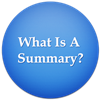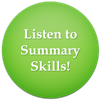Read
the transcript of the listening material
and learn the red new words
first.
Then
finish the exercises about the new words and summary skills.
AA: I'm Avi Arditti and
this week on WORDMASTER: our guest is Emily Kissner, a schoolteacher in
Pennsylvania and author of a book called "Summarizing, Paraphrasing and
Retelling."
EMILY KISSNER: "When you
summarize, you need to first choose what's important in the text --
look for the main ideas. And a good way to do that is to look at what
the author refers to over and over again, because that's probably
what's important.
"And then
you need to condense
those main ideas. You need to get rid of the repeated ideas. You need
to exclude the trivia, those little details that are in there to keep
you interested but really don't contribute to the main idea."
AA: "And
then from there, you've boiled
it
down, you're looking for the important ideas, how do you
begin to put them down on paper?"
EMILY
KISSNER: "Different readers use different methods. There's been a lot
of research on retelling, which is where you just retell the important
ideas to someone else. Even without someone telling you it's good or
bad, retelling what you've read changes something about how you store
the information in your brain and helps you to understand it better. So
one great way to start summarizing is just to turn to someone else and
say 'Hey, I just read this, listen to what the author's talking about.'
"And from
there, you can maybe list some of the main ideas. And then if you need
to write a formal
summary to give to someone else, you can kind of look for the
connections between those ideas and then use those to frame your
summary."
AA: "You
write in your book here, you say: 'Left to their own devices,
most students write the topic of a text when they're asked to write a
main idea.' Now what's the difference between the topic and the main
idea?"
EMILY
KISSNER: "The topic is usually just one word or phrase to which
everything in the text refers. So, for instance, if you were reading
about dinosaurs, the topic of the book could be 'dinosaurs.' A main
idea is usually a sentence that explains why the topic is important or
explains something about the topic. So one article about dinosaurs
might be 'dinosaurs evolved to many unusual creatures.' And so then
everything in the text would go back to that main idea."
AA: "Do you
find these techniques of summarizing to be helpful at all, or
especially helpful, to English learners?"
EMILY
KISSNER: "Where I teach right now, we actually have quite a significant
population of students who are learning English, and one method that I
found especially helpful for them was looking for key words in the
article or the text. And so we would kind of develop their background
knowledge first, and then they would look for key words that were
important.
"And using
some of these techniques like finding the main idea and looking for the
structure of the text helped them to -- by the end of the year, they
were writing some really competent summaries. And that really shows
they were understanding the texts."
AA: "What
would a bad summary look like?"
EMILY
KISSNER: "A lot of students, and a lot of adults, use what's called the
copy-and-delete method: 'Oh geez, I have to write this summary. I don't
really know how. I'm just going to go through and pick up a few
sentences here and a few sentences there, copy it down, I'll leave out
a few sentence, and I have something that looks like a summary.' So
when you're seeing a lot of text that's directly taken out of the main
article, you can tell that the writer of that summary isn't working
with very effective strategies for summarizing."
AA: "Now
what's the difference between summarizing and paraphrasing? Since the
title of your book is 'Summarizing, Paraphrasing and Retelling,' what's
the difference?"
EMILY
KISSNER: "Paraphrasing is just putting ideas into your own words. So,
for instance, you could read a paragraph about global warming and you
could paraphrase it and it could be just as long as the original
paragraph. The key part with paraphrasing is that it's in your own
words. With summarizing, you have a more formal product that is shorter
than the original text."
AA: No one
says any of this is easy, even for teachers. Emily Kissner recalls the
day she told her students about her book.
EMILY
KISSNER: "And then one kid just looked at me, and raised his hand and
with a kind of sly smile said, 'Missus Kissner, could you summarize the
book for us?' And suddenly I was put
on
the spot and I had to put all of what was in the book to
the test to try to summarize this book in a way that the students could
understand."
AA: "And
did you pass the test?"
EMILY
KISSNER: "Well, I think I did. It's hard to do on the spot."
AA: Emily
Kissner is a schoolteacher in Pennsylvania and author of the book
"Summarizing, Paraphrasing and Retelling." And that's Wordmaster for
this week. Archives
of our segments are at voanews.com/wordmaster. I'm Avi Arditti.
Click here to explore more learning methods!
To explore more:
http://www.manythings.org/voa/wm/ |
Choose
one of the new words to complete the following sentences.
Pay attention to the form of the words.
1.
There are two ways to browse the , by subject and
by year .
2. The original speech I had written got
to about ten minutes.
3. She has a very manner, which can
seem unfriendly.
4. The article into just two pages.
5. The interviewer's questions really . (him)
6. Sending advertising by email is very successful as a
marketing .
Answers:
1. archive
2. boiled down/ condensed
3. formal
4. was condensed/ boiled down
5. put him on the spot
6. device |
Now please try to summarize the article on the left
using the techniques that has been mentioned
and send it to me after you finish.
(Hint:
What are the methods or techniques of summarizing?)
|









